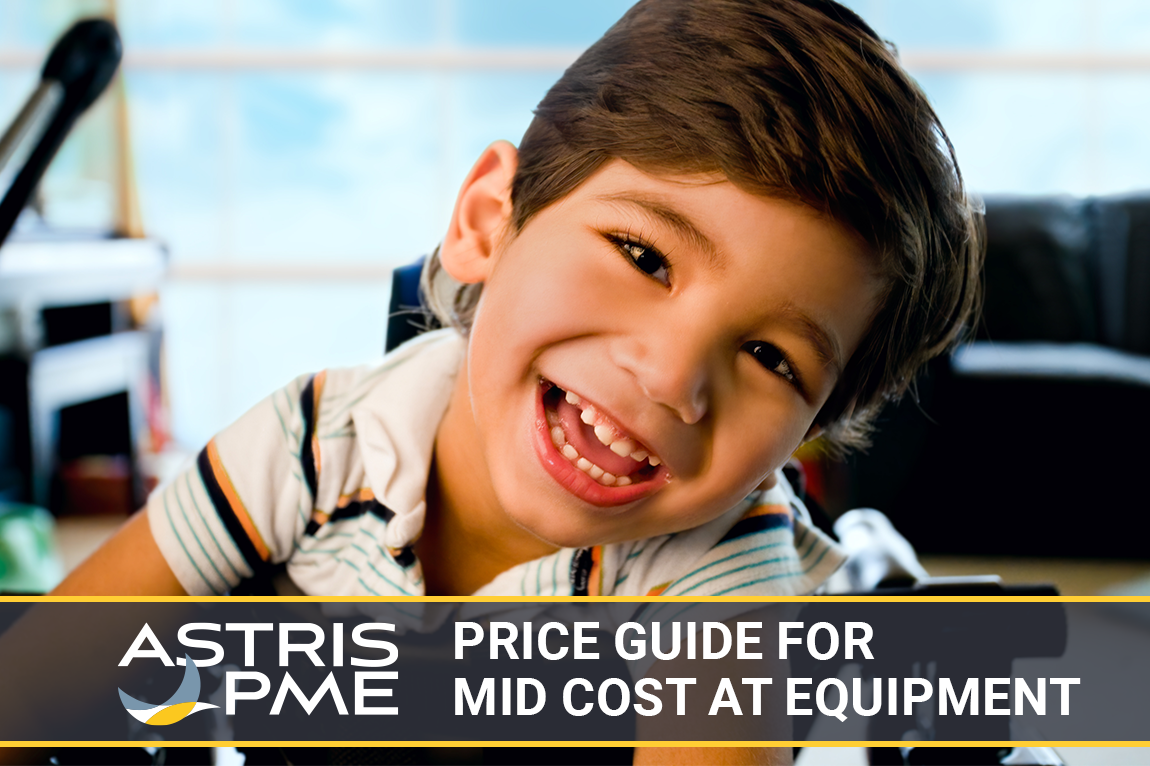Astris PME Price Guide for Mid-Cost AT Equipment

When applying for Mid-Cost Assistive Technology to be included in your plan, you need to ask your Occupational Therapist or Physiotherapist to write you a letter that you can use to submit to NDIA. This letter needs to include: (1) the type of equipment you are looking for, (2) why it will help you reach your goals, and (3) an estimation of how much the equipment is expected to cost.
We have published the below price guide to assist you and your therapist to estimate the price of equipment. Note this is a guide only and does not take into account your particular needs.
AT Price Range Reference Guide





" />








1) Is the price guide a quote?
- No. It is an indication of what different types of equipment typically costs. Small size equipment (eg infants) typically costs less than large size equipment (eg adult, or bariatric). More complex needs require more complex equipment and accessories, and this will also increase the cost. The below guide is split up with 6 different levels of complexity, and each one has a range of prices. Liaise with your therapist to see where they estimate your needs will be, so the correct estimate can be submitted to NDIA. If your therapist is not sure, they can always reach out to Astris PME for advice.
2) What equipment is classified by NDIA as Mid-cost?
- The NDIA class any Assistive Technology that costs between $1,500 and $15,000 as Mid-cost.
- Equipment less than $1,500 is refered to as Low-cost, and equipment over $15,000 is refered to as High-cost.
3) Do I need to submit a written quote to NDIA for Mid-cost Equipment?
- No. From 1 March 2022, the NDIA no longer require written quotes for Mid-cost Assistive Technology. The price guide is sufficient.
- If your equipment cannot be sourced under $15,000, then you will need to apply for High-cost Funding, and a written quote will be required.
4) How accurate does our estimate need to be?
- It is impossible to accurately estimate the cost of your equipment until after you have done your trials, and received advice from both your therapist and your Astris PME AT Consultant.
- Price ranges given to NDIA would normally be within a $5,000 price range. As an example, the range submitted may be $7,000-10,000.
5) How much will NDIA know to fund?
- The NDIA fund in $5,000 increments, so would normally add either $5,000, $10,000 or $15,000 to plans for Mid-cost Equipment.
- Any surplus funds (between what has been allocated vs what the equipment costs) can be used for aligned equipment or services. This may be for a service package for your equipment, or for accessories for your equipment. You can discuss this with your equipment consultant, so they help you with the best package for your needs.
6) Do we need to specify a brand or exact model when applying for Mid-cost Funding?
- No. When you are applying for Mid-cost Funding you do not need to know the brand or model of the equipment you will end up selecting.
The process is:
i. Apply for the Mid-cost Funding.
ii. Once approved, arrange equipment trials (with your therapist).
iii. Once you have confirmed the brand and model you require, as long as the NDIS Provider can supply you the equipment within your budget, you can order it.
iv. Once ordered, your supplier will build the equipment, and bring it out to you. You need to have your therapist there during the delivery, to assist with the fitting.
PLEASE NOTE:
The pricing in this quick reference guide are an indication only, and do not constitute a formal quotation or offer to supply at this pricing. The pricing here has been summarised from thousands of items of Assistive Technology we have supplied over the last 12 months. It is our goal to continually update this guide, as prices change in the market place.
The sole purpose of this guide is to assist therapists and their clients with better understanding expected cost prices for a wide range of Assistive Technology, especially equipment that falls between $1,500 and $15,000. Before recommending any specific piece of equipment, we strongly recommend a full trial is completed with the client (and their carer, if relevant), their therapist and an Equipment Consultant from Astris PME.
Astris PME will not be liable for any short funding that occurs through reliance on the information in this guide. Astris PME makes no promise or guarantee as to the availability or suitability of any item of equipment. For bespoke, specific advice, please contact Astris PME so a consultation workshop can be set up, where the client’s specific needs, conditions, goals, etc, can be considered, and a recommendation put forward.

